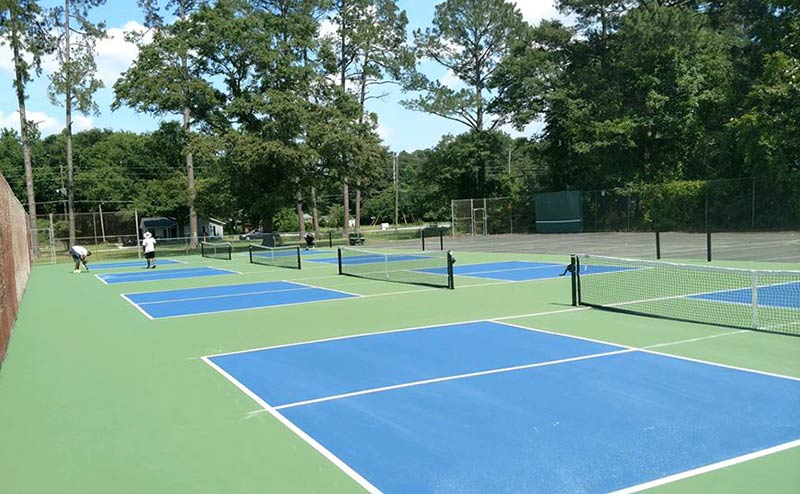Pickleball Court Construction Price Guide-- What to Anticipate
Pickleball Court Construction Price Guide-- What to Anticipate
Blog Article
Lasting Practices in Pickleball Court Building You Ought To Know
As the popularity of pickleball proceeds to climb, so too does the requirement for sustainable techniques in court building and construction. This strategy not only addresses ecological issues but also boosts the durability and capability of the courts. From selecting environment-friendly materials to executing effective drain and energy-saving illumination services, there are countless methods to think about. The effect of these practices extends much beyond the court itself. Recognizing just how each aspect adds to an extra lasting future welcomes better exploration right into the detailed equilibrium between recreational growth and ecological stewardship.
Selecting Eco-Friendly Products
Choosing green products is a crucial action in the building of lasting pickleball courts. The selection of sustainable products not just reduces ecological influence but also enhances the durability and performance of the court. Key materials include recycled rubber for the surface area, which uses superb toughness and shock absorption while drawing away waste from land fills.
In addition, making use of locally sourced materials reduces transportation discharges and sustains local economies. Pickleball court construction. For instance, making use of native hardwoods for secure fencing and seats can supply a lasting aesthetic while making certain strength versus the elements.
Including absorptive products for court structures can additionally add to sustainability by permitting natural water drain and lowering overflow. These selections not just safeguard regional environments but also promote healthier play environments.
Reliable Water Drainage Solutions
While the selection of environmentally friendly materials is essential, applying efficient drain remedies is equally critical for keeping sustainable pickleball courts. Correct water drainage not only secures the court surface area from water damage yet additionally decreases disintegration and runoff, advertising environmental integrity.
Reliable drainage systems can include permeable paving, which enables water to penetrate the ground instead of pooling externally. This decreases the chance of standing water, which can lead to mold and other maintenance concerns. In addition, including strategically put drain channels and swales can guide excess water away from the court area, making sure a completely dry playing surface and stopping soil disintegration.
Utilizing indigenous plant life in the landscaping around the courts can even more enhance drain by taking in excess water and minimizing overflow. These plants need less watering and advertise biodiversity, straightening with lasting methods.
Moreover, it is vital to routinely preserve the drain system to ensure its lasting performance. This includes clearing particles and tracking for obstructions. By focusing on reliable drainage services, pickleball court builders can dramatically add to the sustainability and durability of the facility, ultimately benefiting both players and the setting.
Energy-Efficient Lights Options
As the need for pickleball proceeds to grow, incorporating energy-efficient illumination options into court style has actually become progressively crucial for sustainability. Traditional illumination systems often eat extreme power, adding to go right here greater functional expenses and environmental effect. Adopting modern-day, energy-efficient technologies is important for both brand-new buildings and restorations.
LED (Light Emitting Diode) illumination stands apart as a leading selection because of its longevity and power savings (Pickleball court construction). Contrasted to conventional illumination, LEDs make use of around 75% less energy and can last as much as 25 times longer, considerably lowering upkeep costs. In look at here now addition, the directional nature of LED lights lessens light pollution, ensuring that lighting is concentrated on the court rather than surrounding locations.

Sustainable Surface Area Alternatives
Checking out lasting surface area options for pickleball courts has acquired grip amongst builders and players alike. The focus on environment-friendly products not only aligns with the growing environmental recognition but additionally enhances the efficiency and durability of the courts.
One prominent choice is the usage of recycled rubber, which can be sourced from made use of tires. This material gives excellent shock absorption, reducing the threat of injuries for players while advertising sustainability. In addition, modular ceramic tiles made from recycled plastics use an additional viable option. These tiles are easy to mount and change, and their flexibility enables for numerous court configurations.
Natural turf courts are likewise becoming a sustainable option, promoting biodiversity and lowering the warmth island result. Nevertheless, they need routine upkeep and water, which might not straighten with all sustainability goals.

Water Conservation Strategies

An additional effective method includes the installation of rainwater harvesting systems. These systems save and gather rain for use in maintaining court surfaces and landscaping. This method not only saves potable water however additionally lowers dependence on municipal sources.
Additionally, using drought-resistant landscaping around the courts is necessary. Native plants require less water and are better adapted to regional climate conditions, hence lowering total water consumption. Additionally, using reliable watering systems, such as drip irrigation, ensures that water is supplied directly more to plant origins, minimizing evaporation and waste.
Conclusion
Integrating sustainable techniques in pickleball court building and construction substantially adds to ecological conservation and source performance. By prioritizing these practices, the construction of pickleball courts can line up with more comprehensive ecological goals while promoting long life and capability within communities.
As the appeal of pickleball continues to rise, so as well does the demand for lasting techniques in court building.Picking green products is an essential action in the building and construction of sustainable pickleball courts. By prioritizing energy-efficient lights options, pickleball court erectors can contribute to a much more sustainable future while fulfilling the demands of players and stakeholders alike.Incorporating sustainable surface options not just boosts the efficiency of pickleball courts but also paves the means for implementing effective water conservation strategies.Incorporating sustainable methods in pickleball court building significantly contributes to ecological conservation and resource effectiveness.
Report this page